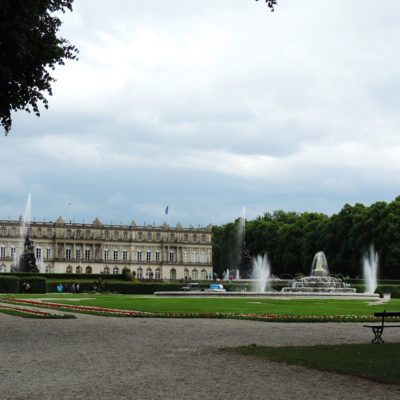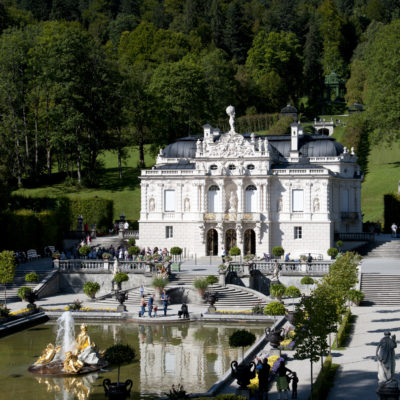When visiting World Heritage Sites in Bavaria, King Ludwig II’s two palaces Linderhof and Herrenchiemsee and the castle Neuschwanstein offer a nice detour. Many tourists actually believe one of those to be a World Heritage Site, but wrongly so. Equally wrong are those who consider it a copy of Disney’s Cinderella castle. But let me start at the beginning…
Ludwig II lived between 1845 and 1886, and ascended to the Bavarian throne in 1864. He was a generous patron of the arts and initiated and financed many architectural and artistic projects. The older he became, though, the less he bothered with matters of state and was considered to live in a sort of dream world, hence his nickname ‘Märchenkönig’, or fairy tale king. He was considered mad by many contemporaries and eventually declared insane and deposed as king. Shortly after, he was found dead on the shores of Lake Starnberg, but the initial explanation of suicide by drowning did not hold when it was discovered that there was no water in his lungs. The mystery probably won’t be solved any more, and whether Ludwig II truly was a little mad or just a misunderstood eccentric, Neuschwanstein, Linderhof and Herrenchiemsee make for excellent sightseeing destinations.
Neuschwanstein probably is the most famous of the three, and often mistaken for either a World Heritage Site or a copy of Disney’s Cinderella castle. The amount of misinformed drivel you are confronted with by accidentally listening in on tourists’ conversations could make your blood freeze. But don’t let me get carried away by this, one of my pet peeves.
What Neuschwanstein Castle certainly is, is one of the most photographed castles in the world. I have visited Neuschwanstein Castle twice so far, and both times I was more than a tad frightened of being trampled underfoot by the hordes of visitors. The sheer number is mindblowing; 1.5 million visitors per year, according to Wikipedia. But then Neuschwanstein really does offer everything people look for in a castle:
It is situated in a lofty spot in the mountains (though not so high up you couldn’t reach it), it has lots of towers and turrets, and nooks and crannies, and once you have made it up, there are spectacular views across the foothills of the Alps and the Allgäu region. Not to forget the legends that still keep popping up of a deranged king trying to build an idealised version of a castle, only to committ suicide (or be killed, rather) before it was even finished.
- Schloss Neuschwanstein. © Bayerische Schlösserverwaltung. Foto: Fotostudio Samer, Peter Samer, Füssen. www.neuschwanstein.de
- Neuschwanstein – View from below with barn
- Neuschwanstein – Zoomed in
- Neuschwanstein – View from below with meadow
Despite having visited the castle twice, there is much more to see. I would especially recommend taking some time for longish walks in the area, because those would provide stunning views of the castle from different viewpoints – and the landscape itself is beautiful and makes for a perfect holiday destination, especially if you’re into hiking, biking or paragliding.
- Schloß Neuschwanstein. © Bayerische Schlösserverwaltung. Thronsaal (R.2), Blick nach Süden (Zweitbelichtung vorhanden)
- Neuschwanstein – Summer meadow
- Neuschwanstein – View from below with woods
Building works on Herrenchiemsee – or more correctly, Herrenchiemsee New Palace – were begun in 1878 and, as with Neuschwanstein castle, never finished due to Ludwig II’s death in 1886. The palace is located on Herreninsel island within Lake Chiemsee and offers spectacular views of the surrounding countryside and especially towards the Alps mountain range. Despite the rather large number of visitors I encountered, the island offers quiet and tranquility. You can walk through woods and fields, or take a trip on a horse-drawn carriage. I even saw several young deer when I was there. Due to the size of the island, visitors aren’t all lumped together all the time, except for the waiting areas for the boat transfers to the Fraueninsel island and the mainland.
- Herrenchiemsee Palace – Front with Gardens
- Herrenchiemsee, Neues Schloss. © Bayerische Schlösserverwaltung. Luftaufnahme, Blick von Westen
- Herrenchiemsee, Neues Schloß. © Bayerische Schlösserverwaltung. Paradeschlafzimmer (R.7). Nach der Restaurierung
- Herrenchiemsee Palace – Statue
- Herrenchiemsee Palace – Side View
- Herrenchiemsee Palace – Rear View
Most remarkable about Herrenchiemsee palace is that it was planned as a copy of Versailles. I think that similarities in the garden’s layout are certainly there, but it would take a lot more to even come close to Versailles’ grandeur. Notwithstanding, Herrenchiemsee palace is striking, and in my eyes it gains most through its situation: If I had a chance to build myself a palace, I would definitely enjoy a location surrounded by woods and water.
- Herrenchiemsee Palace – Deer in Park
- Herrenchiemsee Palace – Jetty with Mountains
- Herrenchiemsee Palace – Chapel seen from Chiemsee
Linderhof palace is perhaps the most extravagant of the three building projects, and shows Ludwig II’s eccentricity best: It sports a hermitage, grotto, Moorish kiosque and Morroccan House, as well as lavish interior design inside the palace. Linderhof is also the only building project that King Ludwig II saw completed. The palace grounds are situated within the Ammergebirge Nature Reserve, which makes for beautiful surroundings, and the palace was actually built on the site of an old hunting lodge. To be honest, though, I believe I would have preferred the unspectacular hunting lodge over the overwrought style of the new palace…
- Schloss Linderhof. © Bayerische Schlösserverwaltung. Hauptfassade, Blick von Süd-Osten über das Wasserparterre und das Bassin mit vergoldeter Springbrunnengruppe ‘Flora und Putten’ von M. Wagmüller
- Schloss Linderhof, Schlosspark. © Bayerische Schlösserverwaltung. Außenansicht der Einsiedelei des Gurnemanz, gestaltet nach einem Bühnenbild in ‘Parsifal’ von Richard Wagner
- Schloß Linderhof. © Bayerische Schlösserverwaltung. Spiegelsaal (R.12), Entwurf von G. Dollmann und J. de la Paix, 1874, Blick Richtung Nord-Ost
All three palaces are easily accessible from Munich, though not in one day. As they are each located in beautiful surroundings, I would recommend at least an overnight stay for each rather than just going for a short trip from Munich. Neuschwanstein is located close to the World Heritage Site Pilgrimage Church of Wies (or Wieskirche), which I’ll soon write about, as well.
I would like to thank the Bayerische Verwaltung der staatlichen Schlösser, Gärten und Seen for granting me a photo permit for exterior photographs at the three palaces and for providing additional photos (see captions above for details).

 Neuschwanstein - Featured Photo
Neuschwanstein - Featured Photo

















